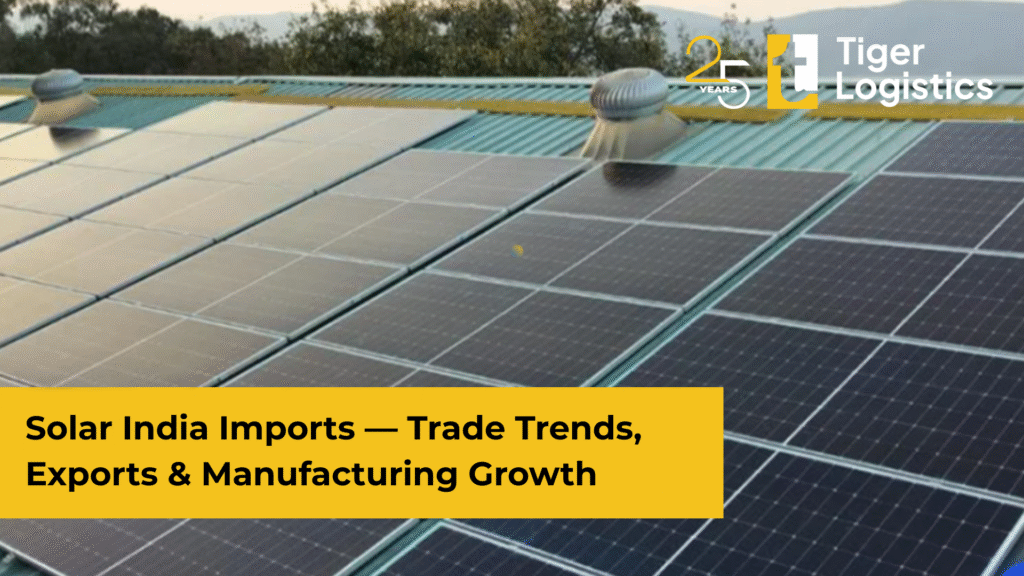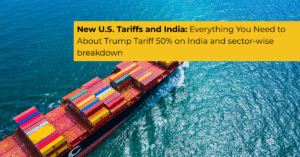
Solar India Imports & Exports — Current Trade Landscape
Solar India imports have reached unprecedented volumes, with the country importing over 35.26 million solar photovoltaic modules worth USD 1.6 billion in FY 2024-25, primarily from China. While India imports large volumes of solar cells and modules, the country is simultaneously emerging as a major exporter of assembled PV modules to the U.S. market. Domestic manufacturing is growing fast thanks to PLI (Production Linked Incentives) and ALMM (Approved List of Models and Manufacturers) policies, but upstream inputs like wafers and polysilicon remain the weak link in achieving true self-reliance.

Imports Current Trends & Key Markets
Top supplier
China is the single largest source for solar cells and modules to India; other suppliers include Vietnam, Malaysia and Indonesia. Solar India imports are dominated by finished modules and cells (the wafers/cells that get assembled into modules). According to recent data, China accounts for 60-80% of India’s solar module and cell imports.
What we import
Two main products drive solar India imports — solar PV modules (finished panels) and solar cells (to be assembled into panels). Recent government and market actions have already pushed module imports down as domestic capacity grows.
Exports Current Trends & Key Markets
Top buyer
The United States is by far the largest buyer of Indian-made PV modules (almost all the export value in recent reporting periods went to the U.S.). Other destinations include African markets, Bangladesh, Nepal and some Middle East buyers. Learn more about India’s renewable energy policies from the Ministry of New and Renewable Energy.
What we export
Mostly assembled PV modules (complete panels). Export volumes rose sharply in FY2024 (several GW exported), driven by Indian factories producing modules for the U.S. market.

Shortage of Domestic Manufacturing Capacity
Under government programs (PLI + ALMM), India reported operational capacities (as of mid-2025) of ~18.5 GW of module manufacturing, ~9.7 GW of cell capacity, and ~2.2 GW of ingot/wafer capacity — a big jump, but still short of full upstream integration needed to reduce solar India imports dependency.
Challenges & Key Bottlenecks
- Even with growing capacity, India still lacks manufacturing of wafers and polysilicon at scale. Most domestic module production depends on imported cells or cell inputs, keeping solar India imports at high levels.
- Cost differences remain: imported (especially from China) inputs are often cheaper. Domestic manufacturing must contend with higher input costs, scale inefficiencies, and infrastructure gaps.
- Trade policy and global tariffs pose risk: export markets are sensitive to tariffs, anti-dumping duties, and changing regulatory regimes. Domestic demand must sustain growth even if export revenues fluctuate. Read more about India’s renewable energy sector from IBEF.

Conclusion
India is moving from an import-heavy market to a growing export hub for modules, but to reduce solar India imports dependency it needs to:
- Scale upstream production (polysilicon → wafers → cells)
- Keep policy predictable (PLI/ALMM enforcement)
- Lower domestic costs via technology and scale
Solar India imports figures remain substantial and still rising in some segments, but policy initiatives are showing early signs of reducing dependency. If current trends continue with increased domestic capacity, tighter procurement rules, and technological progress, India can significantly reduce its import burden. However, unless upstream manufacturing (cells, wafers, polysilicon) catches up, solar India imports dependence will linger.
As India scales its solar capacity, Tiger Logistics dedicated renewable energy vertical TiGreen specializes in handling solar equipment and project cargo, currently moving around 1,500 TEUs monthly from key Chinese ports including Shanghai, Ningbo, and Qingdao to support India’s solar imports.
For specialized solar equipment logistics and project cargo handling, contact Tiger Logistics’ TiGreen vertical for expert support in managing your renewable energy supply chain.






